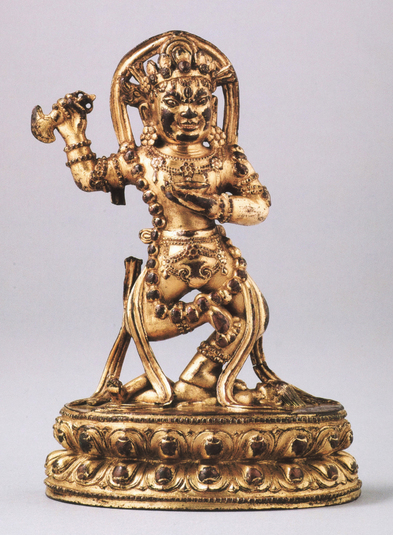
Item: Vajrayogini (Buddhist Deity) - Vajravarahi
| Origin Location | China |
|---|---|
| Date Range | 1200 - 1299 |
| Lineages | Buddhist |
| Size | 15.80cm (6.22in) high |
| Material | Metal, Mercuric Gild |
| Collection | Private |
Classification: Deity
Appearance: Semi-Peaceful
Gender: Female
Vajravarahi according to the tradition of Indrabhuti. (Dated to the Yuan Period).
Vajrayogini is the principal female deity of the Chakrasamvara Cycle of Tantras. She is represented in many different forms, colours, peaceful, semi-peaceful/wrathful and very wrathful. She can have a single face, many faces, and multiple arms. Vajrayogini is the 'genus'- larger category. Vajravarahi is the 'species' - smaller more specific category or type.
Vajrayogini appearing in the form of Vajravarahi is one of the most popular Tantric female deities found in all traditions of Tibetan Buddhism. In this guise she actually has either a single boar's face, or two faces or heads (with a boar's face), two or more hands and legs, red, yellow or black in colour, standing in a dancing posture, or both legs down.
The special iconographic attribute of Vajravarahi is a sow head (varahi) as a single central face, or placed either on her right side of the face (head) or on the top of head. In some traditions she is known as the 'two-faced' Vajrayogini (shal nyi ma). There are many different forms of Vajravarahi and most types have a boar's face. There are a number of traditions where neither the iconography nor the literature prescribe a sows head. In these cases the name Vajravarahi is used as a synonym for Vajrayogini.
Vajrayogini/varahi can be categorized in a number of different ways with either an emphasis on art history, iconography or religious context. She can be divided into colour, posture or types of head(s).
[77] Vajravarahi (Bari Gyatsa): "Vajravarahi, with a body red in colour, one face and two hands. The right [hand] holds, in a manner held aloft, a vajra curved knife. The left holds to the heart a blood filled skullcup and carrying a katvanga [in the bend of] the elbow. Having three eyes and bared fangs. Having a crown of five dry human skulls and a necklace of fifty fresh. Adorned with a garland of flowers. Wearing a lower garment of tiger skin. Standing in a dancing manner with the left leg extended in a half [vajrasana] posture." (Konchog Lhundrub).
Jeff Watt [added 9-2023]
Buddhist Deity: Vajrayogini, Vajravarahi (Early Sculpture)
Buddhist Deity: Vajrayogini, Vajravarahi Main Page
Publication: Images of Faith, A Private Collection of Himalayan Art
Collection: Sotheby's New York (Sculpture, September, 2023)

